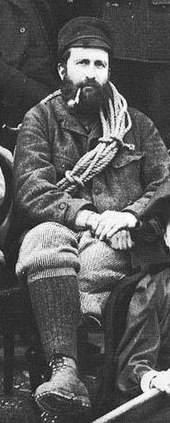Oscar Eckenstein
Oscar Johannes Ludwig Eckenstein (born September 21, 1859 in Canonbury , † 1921 in Oving , Buckinghamshire ) was a British climber and alpinist of German-Jewish descent and inventor of the ten-pointed crampons and the associated Eckenstein technique.
Life
Oscar Eckenstein was born to a German father who left Germany as a socialist in 1848 and an English mother on September 21, 1859 in Canonbury , London. He had two sisters, Amelia and Lina . He attended University College School in London and then studied chemistry in London and Bonn . Socialist like his father, Oscar became an active member of the National Liberal Club . As a railway engineer, he worked for the International Railway Congress Association , an international forum for the clarification of technical questions in the railway sector. In February 1918, at the age of 58, he married Margery Edwards and settled in the village of Oving near Aylesbury , where he died childless soon after in 1921.
Rockclimbing
Eckenstein climbed his first mountain at the age of 13. In 1886 he climbed his first mountain in the Alps. On August 8, 1887, led by Matthias Zurbriggen , he succeeded in the first ascent of the Stecknadelhorn in the Valais Alps . Around 1890 he met Aleister Crowley while climbing in the Lake District , whose friend, rope companion and mentor he became. Other rope companions in Wales were JM Archer Thomson and Geoffrey Winthrop Young and in the Alps Eugen Guido Lammer , Karl Blodig and the young Paul Preuss , whom Eckenstein introduced to the Western Alps over two years .
In 1892, Eckenstein took part in the Karakoram expedition led by William Martin Conway .
In 1902, Eckenstein himself led an Austro-British expedition to the K2 . Participants were: Jules Jacot-Guillarmod as the expedition doctor , Aleister Crowley , Guy Knowles as the financier and the Austrians Heinrich Pfannl and Viktor Wesseley . When attempting to climb K2, Guillarmod and Wessely on the northeast ridge reached an altitude of around 6,600 meters and thus a new world record at this point.
Eckenstein was a well-trained athlete and one of the early pioneers of bouldering . The Eckenstein Boulder in Wales is named after him.
inventor
In 1908, Eckenstein improved the crampon significantly. With its ten points, it was very close to modern crampons. These ten-pointed points made it possible to walk on moderately steep ice up to about 35 ° without taking steps. The foot is angled at the ankle and placed on the ice with the full sole across the fall line . All vertical points grip at the same time. The walk takes place diagonally to the slope in serpentines, the pimple is used to support the mountain side and to keep balance. This climbing technique was also called the corner stone technique (also all-prong technique) after its inventor .
Eckenstein also developed a short ice ax that could be used with just one hand. The pick was 18 centimeters long and the shaft 84 centimeters. He was way ahead of his time. In England, the response to the innovations was initially modest, one reason could have been the tense relationship with the members of the Alpine Club . Eckenstein published about knots and the effective use of nailed mountain boots.
Works
- The Karakorans and Kashmir; an account of a journey. Publisher: T.Fisher Unwin, London, 1896 New edition Publisher: BiblioBazaar, 2009 ISBN 978-1-110-86203-0
Web links
- John Gill : Origins of Bouldering, Oscar Eckenstein… The First Documented Advocate of Bouldering. In: http://www.johngill.net/ . Retrieved April 2, 2010 .
Individual evidence
- ↑ Eberhard Kohlberg, Walter Würtl: Handout mountain course AWI. (PDF) (No longer available online.) AWI Bremerhaven, August 2004, p. 34 , formerly in the original ; Retrieved April 2, 2010 . ( Page no longer available , search in web archives ) Info: The link was automatically marked as defective. Please check the link according to the instructions and then remove this notice.
- ↑ Leo Maduschka / Pit Schubert : Modern ice technology . Bergverlag Rudolf Rother, Munich, 1975, ISBN 3-7633-6012-3 , p. 119-120 .
| personal data | |
|---|---|
| SURNAME | Eckenstein, Oscar |
| ALTERNATIVE NAMES | Eckenstein, Oscar Johannes Ludwig |
| BRIEF DESCRIPTION | British climber and mountaineer |
| DATE OF BIRTH | September 21, 1859 |
| PLACE OF BIRTH | Canonbury |
| DATE OF DEATH | 1921 |
| Place of death | Oving at Aylesbury |
